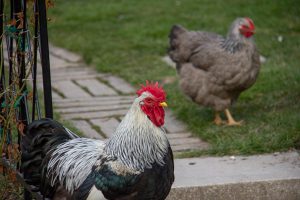Fara and I completed our latest house-sitting assignment a couple of weeks ago, located in one of the small villages surrounding beautiful Lake Balaton in the western part of Hungary. The menagerie of pets we were charged with the care of consisted of three dogs, three cats, three chickens and a rooster, by far the largest number of animals we’ve taken care of to date. Our daily dog walks took us through rolling hills, forests, and vineyards with some spectacular views of the lake. We enjoyed daily eggs provided by the hens and are now considering a flock of our own whenever our travels take us to a more permanent location. Our next house-sit, in the Transylvania region of western Romania, starts in mid-May. Since starting our adventure in August 2017, we have completed four house-sits in four different countries. By the end of 2018, we will have added at least three more to that total and we’re constantly on the lookout for more. It had always been our intention to incorporate house-sitting into our travel plans, we just had no idea how integral it would become.

House-sitting in a nutshell
At the risk of stating the obvious, house-sitting is the practice where a person (the “homeowner”) needing to leave his or her home for a period of time entrusts its care to another person (the “house-sitter”). The house-sitter will often stay in the house while the homeowner is away and assume some of the duties of the homeowner such as simple home maintenance, care of the pets, collecting or forwarding of the mail, security, and generally keeping everything running as if the homeowner was there. In exchange for this service, the house-sitter may be compensated monetarily, through free room and board, use of facilities on the property, or some other means.
House-sitting is often referred to a win-win-win situation for the parties involved. The homeowner gets piece of mind that their property and possessions are being looked after while they are away. In fact, insurers in some countries can nullify a homeowner’s policy if something happens while the homeowner is away and there isn’t someone who is periodically checking on the property. The house-sitter reaps the intangible benefits of living temporarily in another location in addition to other possible forms of compensation. If pets are involved, they win by minimizing the interruption of their daily routines with a stay in a kennel or cattery.
Finding house-sitting opportunities
In the days before the internet, a homeowner would likely find a house-sitter through friends, family or neighborhood connections. My sister and I spent a couple of memorable summers house-sitting for a neighbor down the street who gave us unrestricted access to her swimming pool in return for taking care of her cocker spaniels and mowing the lawn. The online, sharing economy has enabled a global network of homeowners and house-sitters to connect through forums, Facebook groups, job boards and subscription sites making it simultaneously easier and more competitive than ever to find the perfect opportunity. Homeowners who live in popular destinations can expect to be bombarded with tens if not hundreds of applicants wishing to fill the request. House-sitters who travel the globe full time using house-sitting as their primary source of lodging can be booked out several months to a year in advance with confirmed house-sits.
While on our adventure, we have found house-sitting leads in three ways. Our primary source comes from two subscription based web sites, TrustedHousesitters and Nomador. Over the past year, we have tried a few others (see links at the end of the article) with no real success yet. Recently we picked up a house-sit merely by word of mouth. It may seem old school, but sometimes old ways are best. While in Croatia, a local contact Fara met through a completely unrelated channel connected us with a friend in need of a last minute house-sitter. We were in the right place at the right time and knew the right person to get the gig. Finally, homeowners from previous house-sits have started contacting us directly for an encore engagement. We see this as a testament to the care and attention we give to a homeowner’s pets and the professionalism and maturity we show throughout the process. As time goes on, we hope this repeat business becomes a larger percentage of our total house-sitting gigs scheduled.

Getting started
So how does one get started in the world of international house-sitting? Unless you already have a roster of potential clients, we suggest choosing one of the paid subscription web sites to start. Which one to use is always a hot topic for debate and I will leave which is “best” for the many review web sites that can be found with a quick Google search. We started with TrustedHousesitters due to our perception of it being the market leader and it is international with listings from across the globe rather than focusing on a particular country or region. Unfortunately it is also one of the most expensive, currently at $119 per year.
The first thing you’ll need to do with this newly minted account is create your profile. Every platform is a little different with the specifics, but should at the very least have a place to upload photos or videos and an “about you” description. This is your public persona on this site and one of the first things that a potential client will see. Our profile tells a bit about our past and describes the adventure we are currently on. The photos we uploaded show us with various friends’ pets and traveling. In general we want to show that we are trustworthy, love animals and familiar with foreign travel. You’ll be asked to provide contact information (email, phone, skype, social media, etc) and identity verification through uploading a picture of a driver’s license or passport. Finally, there will be a place to list references. This may seem like putting the cart before the horse. How can you have house/pet-sitting references before you get your first house-sitting gig? Over the years, we’ve watched friends’ pets and houses at various times, it doesn’t matter that it didn’t happen through a house-sitting service.
Anatomy of a house-sit
Now that your profile is active, you will likely start receiving daily emails with recently posted house-sitting gigs. Focusing on the posts found in these emails have two advantages over searching the site directly. First, homeowners may get bombarded with more applicants than they could ever realistically sort through. Being as high up in their inbox as possible will increase your chances as many homeowners review applications in the order they were received and cut off the review process once enough suitable candidates have been found. Second, depending on the platform, the posts in the email may not even be searchable on the site for some amount of time after the email has been sent out at which point they may already be closed or have so many applicants it is no longer worth applying for.
After finding the perfect house-sit, you need to actually apply. As part of the application we also send a personal note to the homeowner. Fara uses a combination of pre-canned form letter that restates some of the same things that appear on our profile, updated periodically to reflect the latest news regarding our adventure, and homeowner specific information based on the pets involved or the location of the homeowner. For example, we will add how much the homeowner’s animals remind us of pets we’ve had in the past or if our travels have or will take us to the area the homeowner lives in. To some degree it isn’t much different than applying for an actual job with a cover letter. Showing interest in the house-sit will make you stand out.
Now you wait. The unfortunate reality is that some homeowners are notoriously slow about reviewing applications and may not ever respond with even a polite “thank you for your interest, the position has already been filled” to those who didn’t make the cut. If the house-sit is one we are particularly interested in, Fara will follow up about a week later expressing our excitement at the opportunity to house-sit for them and may even create a sense of urgency by suggesting how important to know if they wish to select us to help coordinate with other house-sits. We haven’t figured out if doing so helps or hinders our chances, so it has been used only sparingly. At some point, we will continue the search in that date range for other house-sitting opportunities.
Eventually your efforts will pay off and a homeowner will respond with interest and the interview phase of the house-sit begins. It might be better described as a negotiation as we are interviewing the homeowner as much as they are interviewing us. On rare occasions this is done entirely over email, but is more commonly a “face-to-face” conversation over video chat. Through sheer luck, one homeowner was located an hour away from where we were staying at the time. So we scheduled a day to drop by for lunch and meet her along with the four-legged family members. The interview is a chance to get to know each other a little better and work out some of the details of the house-sit not covered in previous correspondence. Nailing down the dates of the house-sit is key, including any time before and after the homeowner is actually gone. How the house-sitters will be arriving (car, train, bus, etc) should be discussed as well as if use of a homeowner’s vehicle is offered. We always ask about the details of the daily responsibilities of the house-sitter such as feeding and exercising the pets, gardening or lawn maintenance and whether it is possible to take some day trips to see the surrounding sites. Internet connectivity is important, but as long as their bandwidth can support video chat, we will be happy. Every interview we’ve had so far has ended with “so we’ll see you on such-and-such date” which leads us to believe the homeowner had already decided to select us as house-sitters given nothing unexpected came out of the interview. Between the interview and starting the actual house-sit, Fara is very good about periodically contacting the homeowner to keep the relationship going and make sure there is no unexpected change of plans.
The day will come where you arrive at the homeowner’s house and the sit begins. If you are fortunate enough to have arrived a few days before the homeowner leaves, make the most of it. Go through the daily routines shadowing the home owner or, even better, have the homeowner shadow you. Make sure you understand how everything works (appliances, heating/cooling system, water/gas shutoff, pet routines, etc). Most homeowners will have a “manual” prepared with the important information, so make sure it matches what you are learning from the homeowner directly. On every house-sit we’ve done so far, there is always something that made perfect sense in the presence of the homeowner that we don’t quite understand as soon as we’re alone. We’re not afraid to contact the homeowner while they are gone, but like to minimize the communication of things we could have clarified ahead of time. We’ve also found it useful to have the homeowner show us around the area a bit so we know where the important things are located (grocery store, bank, pharmacy/hospital, veterinarian, etc). Some homeowners also take the time to introduce us to neighbors or other contacts we may find useful while they are gone.
Keeping to a routine is probably the most important thing to do while the homeowner is gone. The pets will be happier and better behaved if you don’t deviate from the feeding, exercising and bedtime schedules set up by the homeowner. Any agreed upon maintenance is easier to do if not put off until the end of the house-sit. In general treat the homeowner’s home as you would treat your own if not better. Fara is also very good about giving the homeowner periodic updates about how the pets are doing, even posting pictures and videos to Facebook as long as the homeowner is okay with us doing so. In our experience, the required work is rarely more than an hour or two a day, so the rest of the time is our own to explore, work on our own projects or just relax.

As the house-sit comes to a close, we like to find out if there is anything the homeowner would like us to restock or have ready for them when they return. The homeowner typically goes out of their way to make sure we are comfortable when we first arrive and it is only fitting that we try to return the favor. We will even try to schedule a time for us to prepare dinner or some other meal for them. This post-sit time-frame is when we recap anything that may have happened in the homeowner’s absence and to continue to build a relationship with them. We have left each of our house-sitting gigs firm in the belief we’ve made new friends and have continued to foster these friendships.
House-sitting for fun and “profit”
At this point you may be thinking house-sitting sounds like a wonderful job and are interested in finding out how much a couple of professional house-sitters like us make. I hate to break it to you, we are not in it for the money. Since we are traveling the world on tourist visas, we don’t have the right to work in any of the countries we’ve visited and are unable to legally charge for our services. We do get free lodging during the duration of house-sit, so you can see that as payment in the form of not having to spend money for an AirBnB or hotel. Given that our lodging expenses average about $50/night, it does add up. Some homeowners leave us with a stocked refrigerator and give us the go ahead to make use of anything that would spoil while they are gone. Sometimes that offer is extended to anything in the pantry or freezer. So you have to factor in money not spent on food as well. We’ve always had our own car, but if a homeowner offers use of their vehicle, that too is a significant benefit in the form of money you don’t need to spend. I will admit that we’ve occasionally been given a small amount of cash (don’t tell the authorities) to reimburse us for something we purchased as a part of the house-sit such as fuel to transport a pet to and from the dog park or restocking of some basic necessities the homeowner wanted when they returned. For us, house-sitting is not a positive cash flow business, instead it can be seen as “not a negative” cash flow (apologies my high school English teachers for the double negative). If I had to put an actual dollar amount to it, we are earning somewhere in the neighborhood of $50-100/day in money staying in our travel fund.
So why do we do it? Earlier I mentioned receiving intangible benefits. We get a chance to travel to places we would normally have no inclination to visit. We get to live in these places like a local; shopping in the same markets, dining in the same cafes, celebrating at the same festivals. We get to meet wonderful people who warmly welcome us into their homes despite being total strangers. We get to scratch the four-legged fur-baby itch without the need to figure out how to travel the world with a pet in tow. Need I say more?
If you’re interested
The links below are the house-sitting platforms we’ve been using, in a rough order of how useful we’ve found them. We only use these platforms as a house-sitter looking for a homeowner and can’t really comment on how well they work from the homeowner’s perspective. In the spirit of full disclosure, the TrustedHousesitters link is an affiliate link giving us two free months in addition to your 20% off.
- TrustedHousesitters — $119/yr, 20% off with this link
- Nomador — $35/qtr, $89/yr
- HouseCarers — free limited membership, $50/yr full membership
- HouseSittersUK — £20 (~$27)/yr
- HouseSitMatch — £49 (~$67)/yr standard, £79 (~$108)/yr premium


In an annoying quirk of bad timing, I just signed up for membership of TrustedHousesitters this week, so couldn’t use your link 🙁 I’m glad you’ve had good experiences with it.